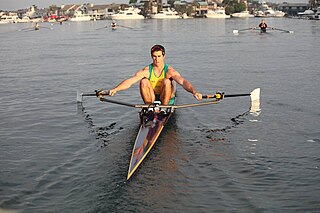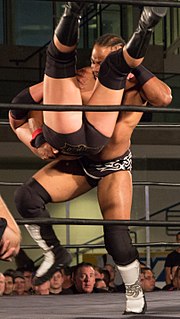
Brickwork is masonry produced by a bricklayer, using bricks and mortar. Typically, rows of bricks called courses are laid on top of one another to build up a structure such as a brick wall.
Professional wrestling throws are the application of professional wrestling techniques that involve lifting the opponent up and throwing or slamming them down. They are sometimes also called "power" maneuvers, as they are meant to emphasize a wrestler's strength. Many of these moves are used as finishers by various wrestlers, who refer to them by several different names that reflect their gimmick. Moves are listed under general categories whenever possible.
Professional wrestling holds include a number of set moves and pins used by performers to immobilize their opponents or lead to a submission. This article covers the various pins, stretches and transition holds used in the ring. Some wrestlers use these holds as their finishing maneuvers, often nicknaming them to reflect their character or persona. Moves are listed under general categories whenever possible.

Drill commands are generally used with a group that is marching, most often in military foot drills or in a marching band. Drill commands are usually heard in major events involving service personnel, reservists and veterans of a country's armed forces, and by extension, public security services and youth uniformed organizations.
A suplex is an offensive move used in sport wrestling as well as amateur and professional wrestling. It is a throw that involves lifting the opponents and bridging or rolling to slam them on their backs.

The leg side, or on side, is defined to be a particular half of the field used to play the sport of cricket. It is the side of the field that corresponds to the batsman's non-dominant hand, from their perspective.

Sculling is the use of oars to propel a boat by moving them through the water on both sides of the craft, or moving one oar over the stern. A long, narrow boat with sliding seats, rigged with two oars per rower may be referred to as a scull, its oars may be referred to as sculls and a person rowing it referred to as sculler.
Aerial techniques, also known as "high-flying moves" are maneuvers in professional wrestling using the ring's posts and ropes as aids, in many cases to demonstrate the speed and agility of smaller, nimble and acrobatically inclined wrestlers preferring this style instead of throwing or locking the opponent. Due to injuries caused by these high risk moves, some promotions have banned the use of some of them. The next list of maneuvers was made under general categories whenever possible.

In wrestling, a pin is achieved by holding an opponent's shoulders to the mat for a three count. Pinfall is the term used in professional wrestling which is a way to win the match for that person or team.
In professional wrestling double-team maneuvers are executed by multiple wrestlers instead of one and typically are used by tag teams in tag team matches. Many of these maneuvers are combination of two throws, or submission holds. Most moves are known by the names that professional wrestlers give their "finishing move" names. Occasionally, these names become popular and are used regardless of the wrestler performing the technique. Moves are listed under general categories whenever possible.

The Boston crab is a professional wrestling hold that typically starts with one wrestler lying in a supine position on the mat, with the other wrestler standing and facing them. It is a type of spinal lock where the wrestler hooks each of the opponent’s legs in one of their arms and then turns the opponent face-down, stepping over them in the process. The final position has the wrestler in a semi-sitting position and facing away from the opponent, with the opponent’s back and legs bent back toward their head. The original name for the maneuver was the Backbreaker, before that term became known for its current usage. In modern wrestling, the Boston crab is not treated as a lethal submission maneuver, even though it was considered a match-ending hold in the past.
Footedness is the natural preference of one's left or right foot for various purposes. It is the foot equivalent of handedness. While purposes vary, such as applying the greatest force in a certain foot to complete the action of kick as opposed to stomping, footedness is most commonly associated with the preference of a particular foot in the leading position while engaging in foot- or kicking-related sports, such as association football and kickboxing. A person may thus be left-footed, right-footed or ambipedal.

In professional wrestling a DDT is any move in which the wrestler has the opponent in a front facelock/inverted headlock and falls down or backwards to drive the opponent's head into the mat. The classic DDT is performed by putting the opponent in a front facelock and falling backwards so that the opponent is forced to dive forward onto their head. Although widely credited as an invention of Jake Roberts, who gave the DDT its famous name, the earliest known practitioner of the move was Mexican wrestler Black Gordman, who frequently performed it during the 1970s.

Backbreaker refers to a kind of professional wrestling move which sees a wrestler dropping an opponent so that the opponent's back impacts or is bent backwards against a part of the wrestler's body, usually the knee. The standard version of the move sees the wrestler scoop their opponent horizontally before dropping to one knee, slamming the opponent's back on their other knee.

A brainbuster is a professional wrestling throw in which a wrestler puts the opponent in a front facelock, hooks their pants or thigh, and lifts them up as if they were executing a vertical suplex. The wrestler then falls onto their back so that the opponent lands on their head while remaining vertical. This move is a version of the DDT. It was innovated by Killer Karl Kox. In Japanese puroresu, the term "brainbuster" refers to a regular vertical suplex, while the move elsewhere known as a brainbuster is referred to as a "vertical drop brainbuster".
Enpi (燕飛), also frequently transliterated as Empi, is a kata practiced by Shotokan and other karate styles. Enpi means Flying Swallow.
Contra dance choreography specifies the dance formation, the figures, and the sequence of those figures in a contra dance. The figures repeat, ideally, in a graceful flowing pattern, aligned with the phrasing of the music. Notably, contra dance figures do not have defined footwork; within the limits of the music and the comfort of their fellow dancers, individuals move to the beat and embellish according to their own taste. Much of the dance is done as a walking movement, one step for each count of the music, while the arms and hands do most of the changing, most of these involving connecting with others' hands.

In rowing, the bow is the rower seated closest to the bow of the boat, which is the forward part of the boat. The other end of the boat is called the stern, and the rower seated there is called the stroke. In a bow-coxed boat, the coxswain is closest to the boat's bow, but the rower closest to the bow is still considered the "bow."

In rowing, the stroke is the rower seated closest to the stern of the boat. In the United Kingdom, the "stroke side" is the port side of the boat, because sweep rowing boats are usually rigged such that the stroke is on the port side of the boat.
Herringbone was a British Thoroughbred racehorse and broodmare, best known for winning two Classics in 1943. The filly won four times from ten races in a track career which lasted from spring 1942 until September 1943. As a two-year-old in 1942 she won twice from five starts but was not among the best of her generation. After being beaten on her three-year-old debut she won the 1000 Guineas over one mile at and finished fourth in the Oaks over one and a half miles a month later. In September she beat a field which included the Derby winner Straight Deal to win the St Leger Stakes over one and three quarter miles. All three of the races took place at Newmarket's July Course. After her second classic win she was retired to stud, where she became a successful broodmare.










